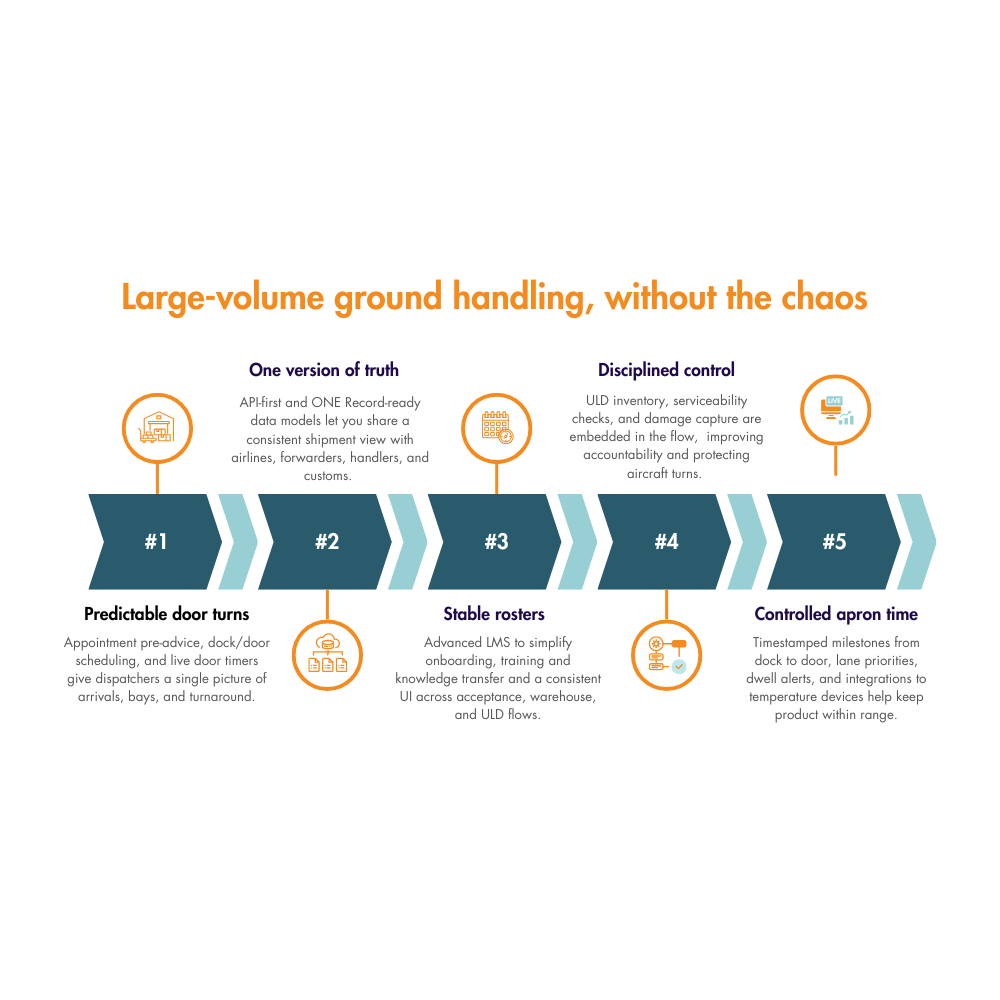Large-volume ground handling, without the chaos
When you’re moving serious tonnage, the pain isn’t just “more of the same.” It’s peaks, fragmentation, and fragile handoffs: truck queues at the gate, scan storms from ULD mishandling, partner data out of sync, and cold-chain exposure on the apron. Hermes tackles the big-handler headaches head-on – so your operation flows at 2,000,000 annual tons just as calmly as it does at 50,000 annual tons.
The problems big handlers face, and how HLT addresses them
- Landside congestion → predictable door turns
Issue: legacy warehouses and constrained truck areas create choke points that ripple through build/break and miss slots.
HLT: appointment pre-advice, dock/door scheduling, and live door timers give dispatchers a single picture of arrivals, bays, and turnaround — smoothing handoffs to warehouse teams. (Plugs into CCS/carrier messaging so arrivals aren’t a mystery.)
- Digital fragmentation → one version of the truth
Issue: EDI + emails + portals = slow handoffs and “where is my cargo?” calls; the industry is moving to ONE Record by 1 Jan 2026.
HLT: API-first and ONE Record-ready data models let you share a consistent shipment view with airlines, forwarders, handlers, and customs, without swivel-chair ops.
- Workforce churn → stable rosters
Issue: recruiting and retaining skilled ground staff remains tough; variability kills throughput.
HLT: advanced LMS to simplify onboarding, training and knowledge transfer and a consistent UI across acceptance, warehouse, and ULD flows shortens ramp-up, tightens handle-time variance, and reduces the need for last-minute shift reshuffles.
- ULD damage and ramp safety → disciplined control
Issue: ULD mishandling remains a costly risk and a safety concern.
HLT: ULD inventory, serviceability checks, and damage capture are embedded in the flow (not on side spreadsheets), improving accountability and protecting aircraft turns.
- Cold-chain exposure → controlled apron time
Issue: the riskiest moments for temperature-sensitive cargo are the handoffs.
HLT: timestamped milestones from dock to door, lane priorities, dwell alerts, and integrations to temperature devices help keep product within range — and make it obvious when it isn’t.
What “good” looks like on Hermes (high-volume edition)
- Door to build, under control: booked slots, live ETAs, and door timers reduce yard dwell and smooth labour allocation.
- Flow > firefighting: smooth onboarding and timely traiing keep freight moving; exceptions are contained early with clear ownership.
- Network-level visibility: multi-station dashboards standardise KPIs so ops leads can spot a bottleneck before it hits tomorrow’s delay board.
- Customers see what you see: ONE Record-ready sharing cuts status chasing and aligns everyone on the same shipment object.
- High-risk lanes behave: ULDs are service-checked and traceable; pharma lanes have measured dwell and escalations; security events are logged against real entities.
At high volume, small inefficiencies snowball. Hermes removes the friction that doesn’t scale – re-keying, status hunting, unplanned queues, ambiguous ownership – and replaces it with flow, shared data, and accountable handoffs. That’s how you keep peaks civilised, protect SLAs, and give airline customers a calm, predictable experience on your busiest days.
